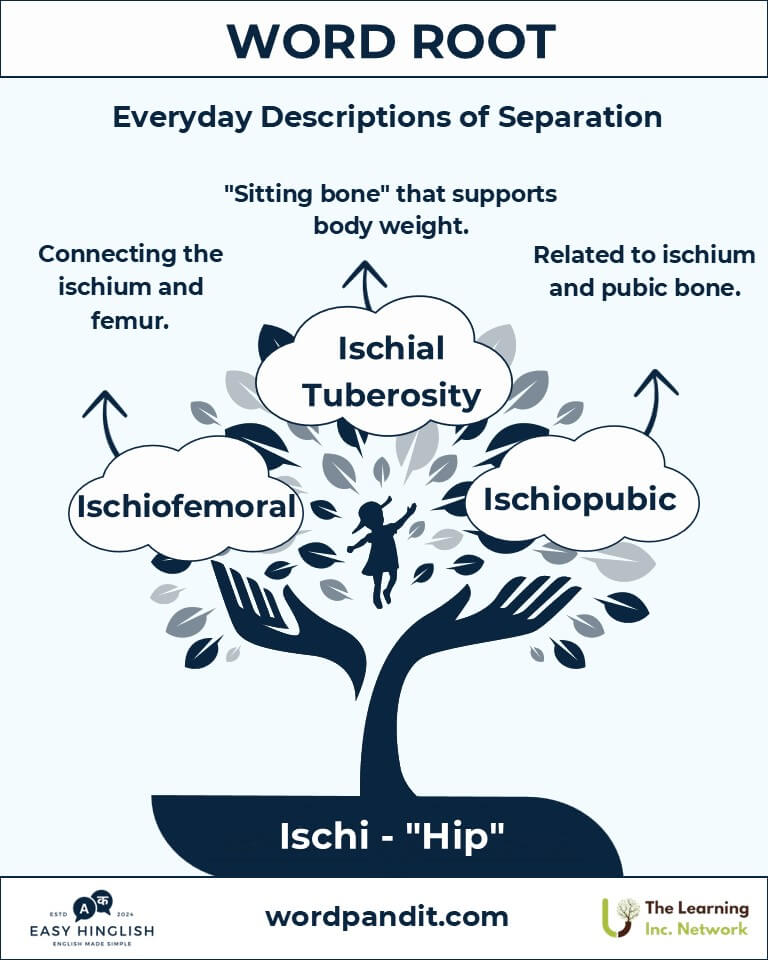Ischi: The Root of the Hip in Anatomy and Beyond
Discover the significance of the root "Ischi," derived from Greek, meaning "hip." Its influence spans anatomical studies and medical terminologies, contributing to a better understanding of the human body and its functions. Learn how this root shapes words like ischium and ischiatic, and its enduring importance in healthcare and biology.

Table of Contents
- Introduction: The Foundation of "Ischi"
- Etymology and Historical Journey
- Mnemonic: Unlocking the Power of "Ischi"
- Common Ischi-Related Terms
- Ischi Through Time
- Ischi in Specialized Fields
- Illustrative Story: "Ischi" in Action
- Cultural Significance of the Ischi Root
- The Ischi Family Tree
- FAQs About the Ischi Word Root
- Test Your Knowledge: Ischi Mastery Quiz
- Conclusion: The Living Legacy of "Ischi"
Introduction: The Foundation of "Ischi"
Did you know that lower body movement and medical terminology are deeply connected? "Ischi" (pronounced "is-kee") comes from the Greek word ischion, meaning "hip." This root forms the basis of words that define hip-related structures and conditions, helping us understand critical aspects of human locomotion and support.

Etymology and Historical Journey
The root "Ischi" comes from the Greek word ischion, which referred to the hip joint or seat bone. Ancient anatomists used this term to describe essential pelvic structures. Over time, it evolved into the Latin "ischium" and was later incorporated into modern medical and anatomical terminology.
Mnemonic: Unlocking the Power of "Ischi"
Imagine a sturdy chair representing the ischium, providing support and stability as you sit. This visualization connects "Ischi" to its foundational role in human anatomy.
Mnemonic Device: "Ischi is the seat of stability—supporting the hips and body in motion."
Common Ischi-Related Terms
- Ischium: The lower and posterior part of the pelvis.
Example: "The ischium plays a crucial role in supporting body weight when sitting." - Ischiatic: Related to the ischium or hip.
Example: "The ischiatic nerve runs through the pelvic region, affecting leg movement." - Ischial: Referring to the ischium.
Example: "Ischial bursitis often results from prolonged sitting on hard surfaces." - Ischiofemoral: Related to the ischium and femur.
Example: "The ischiofemoral ligament stabilizes the hip joint."
Ischi Through Time
- Ancient Anatomy: Greek anatomists identified "ischion" as a key element of mobility and stability.
- Modern Medicine: Terms like "ischial" and "ischiatic" describe pelvic and hip-related conditions and treatments.
Ischi in Specialized Fields
- Medicine:
Ischiatic Nerve: Originates near the ischium and extends down the leg.
Application: Sciatica treatments often focus on relieving pressure in this area. - Sports Science:
Ischial Tuberosity: Known as the "sitting bone," crucial for sports like cycling and rowing.
Relevance: Injuries in this region are common in prolonged sitting activities. - Orthopedics:
Ischiofemoral Impingement: Pain caused by excessive friction between the ischium and femur.
Solution: Therapy focuses on strengthening surrounding muscles.
Illustrative Story: "Ischi" in Action
Dr. Patel, an orthopedic surgeon, treated Emma, a cyclist suffering from severe ischial bursitis. Through targeted therapy and posture adjustments, Emma recovered and regained her passion for cycling. This case highlighted the vital role of the ischium in mobility and support.
Cultural Significance of the Ischi Root
The root "Ischi" reflects humanity's focus on movement and stability. From ancient depictions of seated deities symbolizing power to modern ergonomic designs, the significance of the hip extends beyond anatomy to strength and resilience.

The Ischi Family Tree
- Pelv- (Latin: "basin")
Example: Pelvis - The bony structure housing the hips. - Fem- (Latin: "thigh")
Example: Femur - The thigh bone connecting to the ischium. - Sci- (Latin: "to know or cut")
Example: Sciatic - The large nerve passing near the ischium.

FAQs About the "Ischi" Root
Q: "Ischi" ka kya matlab hai?
A: "Ischi" ka matlab hai "hip" (हिप), jo Greek word "ischion" se aaya hai. Yeh root hip joint ke structures aur unse judi stability aur movement ko refer karta hai.
Q: Ischium kya hai?
A: Ischium pelvis ka lower aur posterior part hai. Yeh shroni ka ek ahem hissa hai jo sitting ke time body ka weight support karta hai aur muscles aur ligaments ke attachment points provide karta hai.
Q: "Ischiatic" aur "Ischial" mein kya antar hai?
A:
Q: Ischial bursitis kya hai?
A: Ischial bursitis ek condition hai jisme ischium ke paas ke bursae (fluid-filled sacs) inflame ho jaate hain. Iska karan hota hai prolonged sitting ya repetitive activities jaise cycling. Symptoms mein buttock area mein pain aur tenderness shamil hain.
Q: Ischiofemoral ligament kya karta hai?
A: Ischiofemoral ligament ek main ligament hai jo hip joint ko stabilize karta hai. Yeh ischium aur femur ko connect karta hai aur thigh ki inward rotation ko rokta hai.
Test Your Knowledge: Ischi Mastery Quiz
1. "Ischi" ka root kya signify karta hai?
2. Pelvis ka kaunsa part ischium hota hai?
3. Ischiatic nerve commonly kya kehlata hai?
4. Kaunsi condition prolonged sitting ki wajah se ischial region ko affect karti hai?
5. Kaunsa ligament ischium ko femur se connect karta hai?
Conclusion: The Living Legacy of "Ischi"
(Ischi ki Jeevant Virasat - इश्ची की जीवंत विरासत)
Ischi root humein hip ki anatomical aur functional importance ke baare mein sikhata hai. Medical terms se lekar daily life tak, iski significance profound hai. Yeh root mobility, stability, aur human anatomy ke intricate design ko samajhne mein madad karta hai.
The "Ischi" root teaches us about the anatomical and functional significance of the hip. From medical terms to everyday life, its importance is profound. This root helps us understand mobility, stability, and the intricate design of human anatomy.








